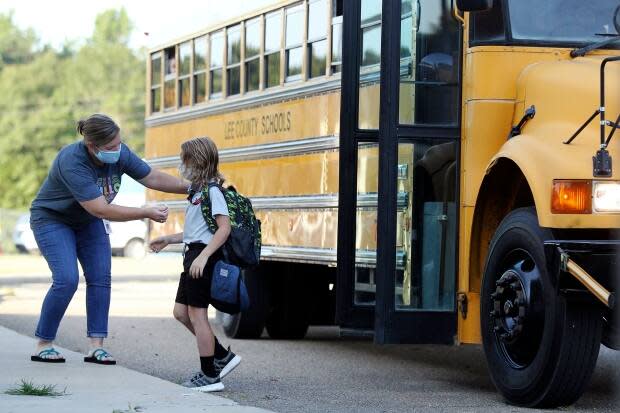Small fraction of students test positive for COVID-19 in Ottawa's largest school board
About one in every 700 students, or 0.14 per cent, in brick-and-mortar classrooms in Ottawa's largest school board have tested positive for COVID-19 since the start of the school year.
According to data from Ottawa-Carleton District School Board (OCDSB) Monday analyzed by CBC News, 84 out of about 58,000 children had a positive diagnosis, but that doesn't mean all of those students contracted the illness at school.
"To me these are mildly encouraging numbers," said Dr. Bill Gardner, a University of Ottawa professor of epidemiology who also specializes in child psychology and statistics.
"Of course we would love to have no cases, but it could be an awful lot worse."
Other school boards show similar trends.
Ottawa Catholic School Board's (OCSB) data provided Friday shows about 0.3 per cent, 107 of its students, have contracted COVID-19 since September.
I don't think kids are perfectly safe, but none of us are perfectly safe. - Bill Gardner, professor of epidemiology, University of Ottawa
CBC could not break down student-specific infection rates for Conseil des écoles catholiques du Centre-Est (CECCE) and Conseil des écoles publiques de l'Est de l'Ontario (CEPEO). But roughly 0.6 per cent of staff and students combined at CECCE, and about 0.4 per cent of staff and students combined at CEPEO contracted COVID-19 since September.
Ottawa's four major school boards have more than 128,000 students back in brick-and-mortar classrooms this year. Thousands of staff are also back in class. Of those, 423 staff and students tested positive since school started, based on the latest numbers provided by the boards between Friday and Monday.
Further, Ottawa Public Health's (OPH) Monday data shows about 0.05 per cent of staff and students, or five in every 10,000, were possibly infected at school.
There were 80 COVID-19 cases across the boards linked to a school outbreak, where health officials believe there's a reasonable chance transmission happened in a school setting.
'Worrisome trends' in last 14 days: epidemiologist
However, more than half of the positive COVID-19 cases — 216 — were confirmed in the past 14 days, suggests the Ontario government's latest data on recent cases in schools.
Epidemiology professor Gardner says those are "worrisome trends," indicating that Ottawa is about to experience a surge in cases.
"This means we need to carefully watch the case numbers in Ottawa schools," he said.
But referring to the overall low percentage of students and staff contracting COVID-19, Gardner said that in-person schools should remain open.
"If school classrooms were a site where lots of infections could spread, we'd see bigger numbers than this," he said, referring to examples of super-spreading events like at the spin studio in Hamilton, Ont.

"I feel like the importance of schooling is such that so far, I'd be willing to continue keeping schools open, and I wouldn't be prone to closing them."
"Schooling is really important and as long as the numbers are this low … my gut feeling is, [it's] safe enough," he said. "I don't think kids are perfectly safe, but none of us are perfectly safe."
The need to collect more school data
But Gardner noted that these numbers reflect the cases that we know of — and doesn't capture the potential asymptomatic children who never get tested. According to experts, children are more likely to have mild or asymptomatic infections than adults.
Unless we keep our eye very carefully on this, we're at risk of things getting out of hand. - Bill Gardner, professor of epidemiology, University of Ottawa
To get a handle on capturing asymptomatic students' data, Gardner suggested regular and random testing of a pool of children at Ottawa's schools.
He called that "ambitious" as it would add more testing demands to an already strained system.
He recognized that governments have multiple competing priorities during the pandemic, but said it's "really important" to spend dollars to collect school data, noting conditions of the pandemic change rapidly.
"I just want to urge the school boards and the [provincial and municipal] governments to devote as many resources they can spare to carefully monitoring data like this, to collect it, to analyze it," Gardner said.
"Even though I'm saying it looks safe enough for me right now, unless we keep our eye very carefully on this, we're at risk of things getting out of hand."
CBC calculated the percentages based on OPH data, provincial data, COVID-19 data on each of the board's websites, and additional data (like student populations in brick-and-mortar classes) provided by each of the school boards. While CBC obtained the total number of staff employed at all four boards, the boards couldn't specify the total number of staff in brick-and-mortar classrooms by publication. CBC used total staff populations to calculate the data.

